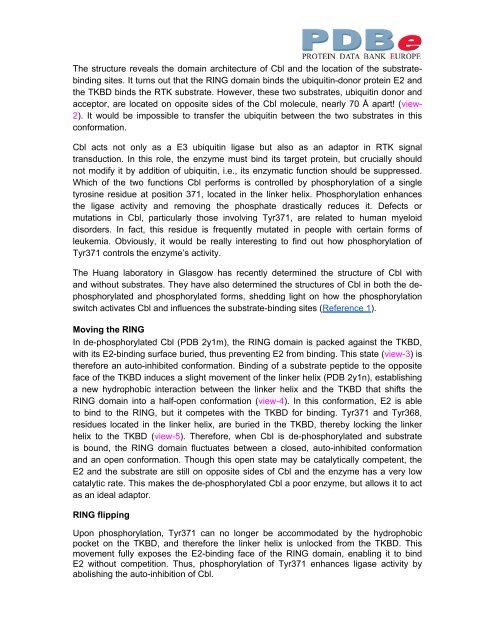Cbl ubiquitin ligase: Lord of the RINGs
Cbl ubiquitin ligase: Lord of the RINGs
Cbl ubiquitin ligase: Lord of the RINGs
You also want an ePaper? Increase the reach of your titles
YUMPU automatically turns print PDFs into web optimized ePapers that Google loves.
The structure reveals <strong>the</strong> domain architecture <strong>of</strong> <strong>Cbl</strong> and <strong>the</strong> location <strong>of</strong> <strong>the</strong> substratebindingsites. It turns out that <strong>the</strong> RING domain binds <strong>the</strong> <strong>ubiquitin</strong>-donor protein E2 and<strong>the</strong> TKBD binds <strong>the</strong> RTK substrate. However, <strong>the</strong>se two substrates, <strong>ubiquitin</strong> donor andacceptor, are located on opposite sides <strong>of</strong> <strong>the</strong> <strong>Cbl</strong> molecule, nearly 70 Å apart! (view-2). It would be impossible to transfer <strong>the</strong> <strong>ubiquitin</strong> between <strong>the</strong> two substrates in thisconformation.<strong>Cbl</strong> acts not only as a E3 <strong>ubiquitin</strong> <strong>ligase</strong> but also as an adaptor in RTK signaltransduction. In this role, <strong>the</strong> enzyme must bind its target protein, but crucially shouldnot modify it by addition <strong>of</strong> <strong>ubiquitin</strong>, i.e., its enzymatic function should be suppressed.Which <strong>of</strong> <strong>the</strong> two functions <strong>Cbl</strong> performs is controlled by phosphorylation <strong>of</strong> a singletyrosine residue at position 371, located in <strong>the</strong> linker helix. Phosphorylation enhances<strong>the</strong> <strong>ligase</strong> activity and removing <strong>the</strong> phosphate drastically reduces it. Defects ormutations in <strong>Cbl</strong>, particularly those involving Tyr371, are related to human myeloiddisorders. In fact, this residue is frequently mutated in people with certain forms <strong>of</strong>leukemia. Obviously, it would be really interesting to find out how phosphorylation <strong>of</strong>Tyr371 controls <strong>the</strong> enzyme’s activity.The Huang laboratory in Glasgow has recently determined <strong>the</strong> structure <strong>of</strong> <strong>Cbl</strong> withand without substrates. They have also determined <strong>the</strong> structures <strong>of</strong> <strong>Cbl</strong> in both <strong>the</strong> dephosphorylatedand phosphorylated forms, shedding light on how <strong>the</strong> phosphorylationswitch activates <strong>Cbl</strong> and influences <strong>the</strong> substrate-binding sites (Reference 1).Moving <strong>the</strong> RINGIn de-phosphorylated <strong>Cbl</strong> (PDB 2y1m), <strong>the</strong> RING domain is packed against <strong>the</strong> TKBD,with its E2-binding surface buried, thus preventing E2 from binding. This state (view-3) is<strong>the</strong>refore an auto-inhibited conformation. Binding <strong>of</strong> a substrate peptide to <strong>the</strong> oppositeface <strong>of</strong> <strong>the</strong> TKBD induces a slight movement <strong>of</strong> <strong>the</strong> linker helix (PDB 2y1n), establishinga new hydrophobic interaction between <strong>the</strong> linker helix and <strong>the</strong> TKBD that shifts <strong>the</strong>RING domain into a half-open conformation (view-4). In this conformation, E2 is ableto bind to <strong>the</strong> RING, but it competes with <strong>the</strong> TKBD for binding. Tyr371 and Tyr368,residues located in <strong>the</strong> linker helix, are buried in <strong>the</strong> TKBD, <strong>the</strong>reby locking <strong>the</strong> linkerhelix to <strong>the</strong> TKBD (view-5). Therefore, when <strong>Cbl</strong> is de-phosphorylated and substrateis bound, <strong>the</strong> RING domain fluctuates between a closed, auto-inhibited conformationand an open conformation. Though this open state may be catalytically competent, <strong>the</strong>E2 and <strong>the</strong> substrate are still on opposite sides <strong>of</strong> <strong>Cbl</strong> and <strong>the</strong> enzyme has a very lowcatalytic rate. This makes <strong>the</strong> de-phosphorylated <strong>Cbl</strong> a poor enzyme, but allows it to actas an ideal adaptor.RING flippingUpon phosphorylation, Tyr371 can no longer be accommodated by <strong>the</strong> hydrophobicpocket on <strong>the</strong> TKBD, and <strong>the</strong>refore <strong>the</strong> linker helix is unlocked from <strong>the</strong> TKBD. Thismovement fully exposes <strong>the</strong> E2-binding face <strong>of</strong> <strong>the</strong> RING domain, enabling it to bindE2 without competition. Thus, phosphorylation <strong>of</strong> Tyr371 enhances <strong>ligase</strong> activity byabolishing <strong>the</strong> auto-inhibition <strong>of</strong> <strong>Cbl</strong>.
















